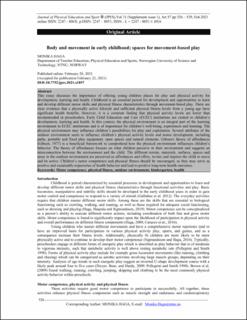| dc.description.abstract | This essay discusses the importance of offering young children places for play and physical activity for development, learning and health. Childhood is an essential period for development and opportunities to learn and develop different motor skills and physical fitness characteristics through movement-based play. There are clear evidence that a physically active lifestyle and sufficient physical fitness levels from a young age have significant health benefits. However, it is a common finding that physical activity levels are lower than recommended in preschoolers. Early Child Education and Care (ECEC) institutions are central to children’s development, learning and health. In this context, the physical environment is an integral part of the learning environment in ECEC institutions and is of importance for children’s well-being, experiences and learning. The physical environment may influence children’s possibilities for play and exploration. Several attributes of the outdoor environment seem to influence children’s physical activity levels and motor development, including paths, portable and fixed play equipment, open spaces and natural elements. Gibson's theory of affordances (Gibson, 1977) is a beneficial framework to comprehend how the physical environment influences children’s behavior. The theory of affordances focuses on what children perceive in their environment and suggests an interconnection between the environment and the child. The different terrain, materials, surfaces, spaces and areas in the outdoor environment are perceived as affordances and offers, invites and inspires the child to move and be active. Children’s motor competence and physical fitness should be encouraged, as they may serve as positive and sustainable trajectories of health behavior and lead to positive long-term health outcomes. | en_US |

